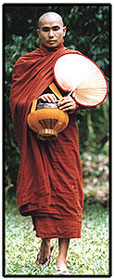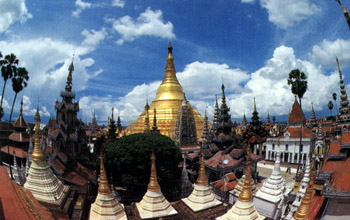 |
|
|
| |
||
| |
|
|
| |
||
|
|
||
| |
||
The Shwedagon Pagoda, Rangoon. The British annexed lower Burma in the 1820s and finally took over the whole country in 1885 although intense opposition to them, meant that Christian missionaries were unable to make much headway. At independence in 1948 Buddhism once again began to receive state support and today about 89% of all Burmese are Buddhists. In the late 19th century there was a great religious revival in the country, and in this century the teachings of two Burmese masters, Mahasi Sayadaw and U Ba Khin, a layman, have become very influential in the West.
Above two Burmese female devotees pour water over an image of the Buddha at the Shwedagon pagoda in Rangoon. This custom is seen as another way of paying respect to the person of the Buddha himself. As Buddhism is a religion
without a God, it might be asked who do Buddhist pray to? Or do
they pray at all? The answer is that most Buddhist pray, but they
are praying to the Buddha within themselves. They believe that
the enlightened nature of the Buddha is their own real nature
which they have not yet been able to reach. So when they pray,
it is to that deepest part of themselves. In all Buddhist countries
the temples are always open, and many people go in during the
day. They bring flowers for the Buddha statue or light a candle
to show their love and respect. Usually they bow to show gratitude
for the Buddha's teachings. Sometime they offer rice or light
an incense stick. These are ways of honouring the Buddha.
|
| |
|||||||
| |
|||||||
| |
Copyright© 2008 - BDEA Inc. & BuddhaNet. All rights reserved. | |
|
|
|
|
|
| |
|||||||
| |
|||||||


